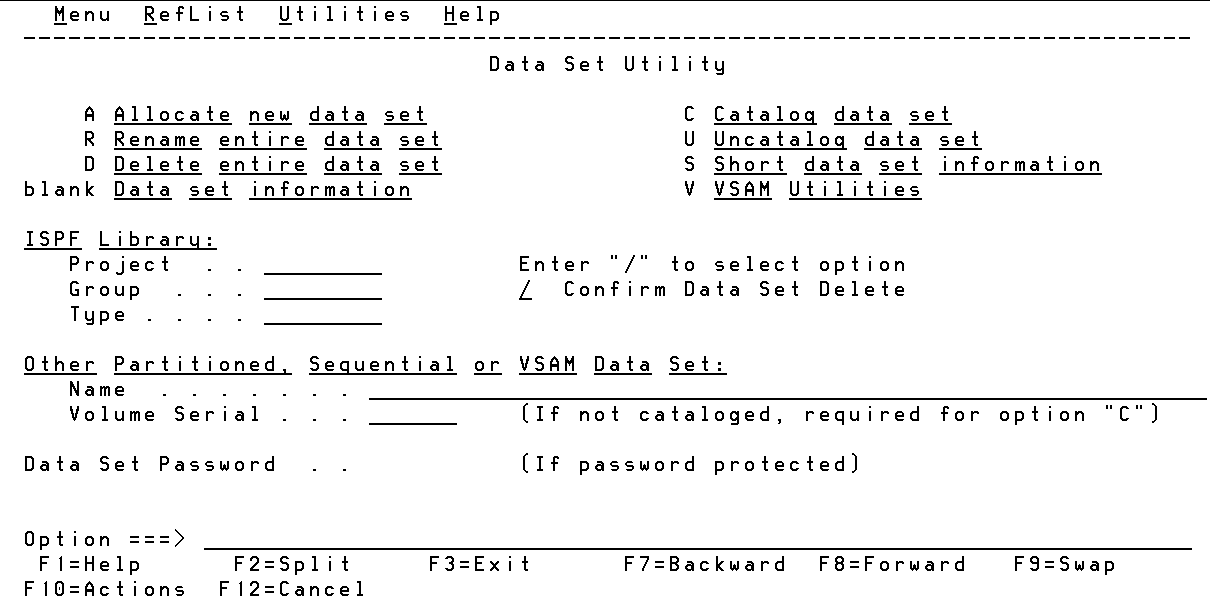Using the Data Set Utility Options
Data Set is the second option on the Utility Selection panel. To access this option, type at the option line and press . The Data Set Utility panel is displayed.

Following is a description of the fields.
- Used to allocate a new dataset. You must do the following:
- Enter an ISPF library name in the Project, Group, and Type fields. The volume in the Volume Serial field is ignored. If you entered another dataset name, you can specify the volume on which to allocate the dataset in the Volume Serial field. If you want to use the authorized default volume or enter a generic unit address in the Generic Unit field on the allocate New Data Set panel, do not enter a volume serial.
- Enter a partitioned or sequential dataset name in the Data Set Name field.
- If your ISPF libraries and datasets are password-protected, enter the password in the Data Set Password field.
- Press .
The new dataset is allocated and cataloged. To return to the previous panel without allocating the dataset, type .
- Used to specify that a particular dataset is cataloged. You must specify the volume serial on which the dataset resides, regardless if the the dataset is specified as project, library, and type, or as another dataset name. The dataset must reside on the specified volume.
- Used to provide a new name to the entire dataset. If you specify a volume serial for a dataset to be renamed, ISPF checks to see if the dataset is cataloged on that volume. If it is, the rename panel prompts you to specify whether to recatalog the dataset. The displayed default for the field is . If you specify a volume serial and the dataset is not cataloged, it remains uncataloged after you rename it. If a volume serial is not specified, the dataset is recataloged to the new dataset name and the old dataset name is uncataloged.
- Used to uncatalog a specific dataset. There is no need for the specified dataset to be allocated or for the volume on which it resides to be mounted. If the catalog entry being removed contains an expiration date, a confirmation panel is displayed.
- Used to delete a dataset. A confirmation panel is displayed when you select (for delete). ISPF checks to see whether the dataset is cataloged on that volume. If it is, the confirm panel prompts you to specify if to uncatalog the dataset. It defaults to Yes. If a volume serial is not specified, and the dataset does not have an expiration data, the dataset is deleted and uncataloged.
- Displays information that resides on Storage Management Subsystem volumes when Digital Flat Panel (DFP) is installed and available and the Storage Management Subsystem is active.
- Displays information about the selected dataset. The information is the same as found on the topic of datasets in the section entitled Using Library Utility Options. For multi-volume datasets, options I and S display current allocation and utilization values that represent totals from all volumes used. When requesting information on a multi-volume dataset, you cannot enter a volume serial.
- Allocates a new dataset by using the Storage Management Subsystem classes (management class, storage class, and data class). A dataset that is allocated on a volume that is managed by the Storage Management Subsystem is referred to as a managed dataset. Conversely, a dataset that is allocated on a volume that is not managed by the Storage Management Subsystem is called a nonmanaged dataset.
- Used to create the IDCAMS commands to define, delete, and list catalog information for VSAM datasets.
See Also |